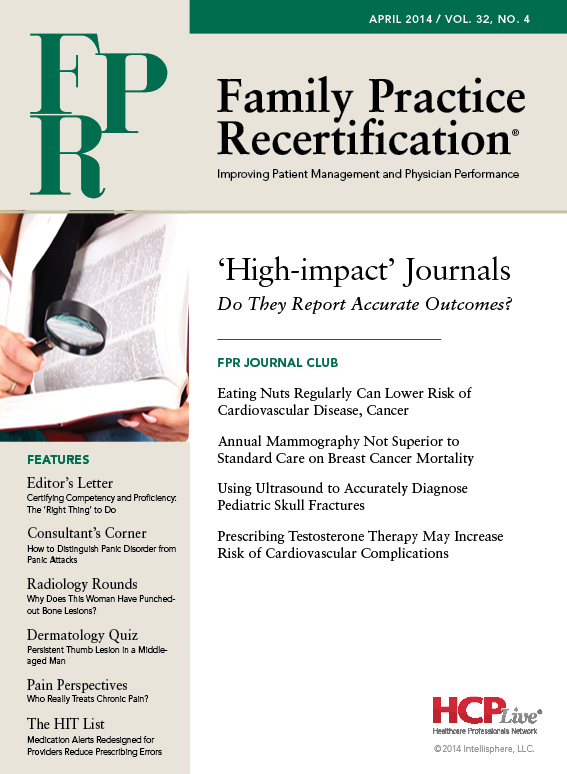Publication
Article
Family Practice Recertification
Who Really Treats Chronic Pain? The Necessity of Pain Management in Family Practice
Author(s):
Family physicians have the opportunity to become leaders in the chronic pain care blueprint.

Michael E. Schatman, PhD, CPE
Pain care has been in a state of crisis in the United States.1-3 While the reasons for this crisis are too numerous to discuss in a single column, one of the primary causes of this dysfunctional system is the fact that pain is treated in an uncoordinated sequential manner, rather than through an integrated biopsychosocial approach. This is where family physicians have the opportunity to become leaders in the chronic pain care blueprint.
A study by Brenda Breuer and colleagues in 2010 yielded startling results.4 In examining who actually treats chronic pain in the United States, the authors found chiropractors treat 40% of cases, acupuncturists treat 7%, pain specialists treat only 2%, and primary care physicians (PCPs) treat 52%. To a certain extent, this can be explained by the lack of pain specialists in this country.
A 2007 study determined there are only 2,500 physicians certified in pain management by the American Board of Medical Subspecialties (Anesthesiology, Neurology, Physical Medicine and Rehabilitation,5 while the American Board of Pain Medicine (ABPM) reported the board certification of 2,200 physicians last year.6 Although there is undoubtedly a considerable degree of overlap between the groups, the datasets inform us that there are a maximum of 4,700 board-certified pain specialists in the US. Since an Institute of Medicine (IOM) report suggested there are 100 million individuals in this country suffering from chronic pain,7 that comes out to one board-certified pain specialist for every 21,276 pain sufferers in America!
These astounding data tell us several things of importance. Aside from the obvious shortage of pain specialists, almost half of all chronic pain is treated by chiropractors and acupuncturists, meaning complementary and alternative medicine practitioners whose treatments are associated with no or weak evidence bases for long-term improvements.8-9 Additionally, it tells us PCPs are already treating a majority of chronic pain cases.
As our population continues to age, the incidence of chronic pain is unfortunately likely to increase. Thus, regardless of whether or not you enjoy treating patients with chronic pain, working with this population will become a progressively larger part of your practice.
Are “pain specialists” necessarily better pain managers than PCPs? I have posited that no physician who treats chronic pain solely from a pharmacological, surgical, or interventional perspective should be considered a specialist; he or she is merely a “subspecialist,” as the full scope of the patient’s pain-related problems are not addressed in such a practice. Thus, it is a mistake to underestimate your ability to treat patients with chronic pain, or to believe that you cannot improve your skills.
Remember, PCPs practice from a more biopsychosocial model than specialists do, and as Rollin “Mac” Gallagher, MD, MPH, once wrote, “the history of pain medicine is replete with failures of the biomedical model.”10 There is no question whether you will treat patients with chronic pain; however, the choice of doing so with passion and a degree of expertise is yours.
References
1. Giordano J, Schatman ME. A crisis in pain care: an ethical analysis. Part 1: facts, issues, and problems. Pain Physician. 2008; 11:483-90.
2. Giordano J, Schatman ME. A crisis in chronic pain care: an ethical analysis. Part 2. proposed structure and function of an ethics of pain medicine. Pain Physician. 2008;11:589-95.
3. Giordano J, Schatman ME. A crisis in chronic pain care: an ethical analysis. Part 3: toward an integrative, multi-disciplinary pain medicine built around the needs of the patient. Pain Physician. 2008;11:771-84.
4. Breuer B, Cruciani R, Portenoy RK. Pain management by primary care physicians, pain physicians, chiropractors, and acupuncturists: a national survey. South Med J. 2010;103:738-47. http://www.ncbi.nlm.nih.gov/pubmed/20622716.
5. Breuer B, Pappagallo M, Tai JY, Portenoy RK. US board-certified pain physician practices: uniformity and census data of their locations. J Pain. 2007;8:244-50. http://www.ncbi.nlm.nih.gov/pubmed/17169616.
6. American Board of Pain Medicine. Frequently Asked Questions. http://www.abpm.org/faq. Accessed on March 16, 2014.
7. Institute of Medicine of the National Academies. Relieving Pain in America: A Blueprint for Transforming Prevention, Care, Education, and Research. Washington, DC: The National Academies Press; 2011.
8. Rubinstein SM, van Middelkoop M, Assendelft WJ, de Boer MR, van Tulder MW. Spinal manipulative therapy for chronic low-back pain: an update of a Cochrane review. Spine. 2011;36:E825-46. http://www.ncbi.nlm.nih.gov/pubmed/21593658.
9. Furlan AD, Yazdi F, Tsertsvadze A, et al. Complementary and alternative therapies for back pain II. Evid Rep Technol Assess. (Full Rep). 2010 Oct;(194):1-764.
10. Gallagher RM. Primary care and pain medicine. A community solution to the public health problem of chronic pain. Med Clin North Am. 1999;83:555-83. http://www.ncbi.nlm.nih.gov/pubmed/10386115.
About the Author
Michael E. Schatman, PhD, CPE, is a clinical psychologist who has spent the past 27 years working in pain management. He is currently the Executive Director of the Foundation for Ethics in Pain Care in Bellevue, WA, where he also maintains a part-time practice in pain psychology. Schatman is the author of more than 80 peer-reviewed and invited journal articles and book chapters on pain management, and he lectures regularly on both local and national bases. He is the editor of Ethical Issues in Chronic Pain Management and Chronic Pain Management: Guidelines for Multidisciplinary Program Development, both of which were released in 2007. Currently, he is Editor-in-Chief of the Journal of Pain Research, Ethics Section Head Editor of Pain Medicine and Psychological Injury & Law, and Deputy Editor-in-Chief of the International Journal of Cannabinoid Medicine. Schatman serves on the Board of Directors of the American Society of Pain Educators, which named him 2011 Clinical Pain Educator of the Year.






